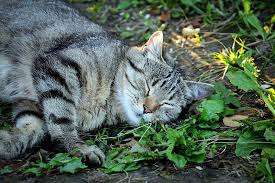Catnip is one of the most fascinating and widely discussed plants among cat lovers. If you have ever watched a cat roll around in apparent bliss after encountering catnip, you might have wondered: What’s in this plant that drives cats wild? Is it safe? Should I give it to my cat regularly?
This article will provide detailed answers to all of these questions. We’ll explore what catnip is, why cats react to it, its health benefits, safe usage tips, and frequently asked questions, all based on reliable sources and veterinary advice.

What Is Catnip?
Catnip (Nepeta cataria), also called catmint, is a member of the mint family (Lamiaceae). It is characterized by green, heart-shaped leaves, small lavender flowers, and a distinct minty aroma. The main active compound in catnip is nepetalactone, an essential oil concentrated in the leaves and stems, which causes the plant’s distinct effects on cats.
Learn more about: Why is my cat sneezing
Historically, catnip was also used in traditional herbal medicine for humans as a gentle sedative. However, today, its most popular use is in feline enrichment and behavior management.
How Does Catnip Work on Cats? The Science Behind the Magic
When a cat smells catnip, nepetalactone molecules travel into the nasal passages and attach to olfactory receptors. These receptors send signals to the brain’s amygdala (emotion center) and hypothalamus (behavior regulation center), triggering a behavioral response.
Common Reactions in Cats Include:
- Rolling, rubbing, or head-butting the source of catnip
- Sudden bursts of energy—running, pouncing, and playful aggression
- Licking, chewing, or drooling on catnip toys
- Purring, meowing, or chirping with excitement
- Short periods of relaxed behavior afterward
Why Do Some Cats Calm Down Instead of Getting Hyper?
When smelled, catnip usually stimulates activity, but when ingested, it tends to have a mild sedative effect, promoting relaxation. This makes catnip useful both for play and stress relief.
Do All Cats React to Catnip?
No—catnip sensitivity is genetic. Studies show that:
- Around 60–80% of cats respond to catnip.
- Kittens younger than 3–6 months typically show little to no interest in catnip.
- Certain cat breeds or individual cats may not respond to catnip at all.
Alternatives for Non-Responders:
- Silver Vine (Actinidia polygama): Often stronger than catnip.
- Valerian Root: Has calming effects on many cats.
- Tatarian Honeysuckle: Another excellent option for enrichment.
Benefits of Catnip for Cats
Catnip is more than just entertainment; it offers physical, mental, and emotional benefits:
Encourages Physical Activity
Indoor cats often suffer from inactivity, leading to obesity and related health issues. Catnip toys encourage exercise through play, keeping cats fit and agile.
Provides Mental Stimulation
Boredom can cause stress, destructive scratching, or aggression. Catnip provides enrichment that keeps cats mentally engaged.
Reduces Stress and Anxiety
When ingested or used in a calm environment, catnip can soothe nervous cats during:
- Vet visits
- Car rides
- Moving to a new home
- Introducing new pets
Aids in Training
Sprinkling catnip on scratching posts or new beds encourages use, helping redirect cats from damaging furniture.
Is Catnip Safe for Cats?
Absolutely, catnip is non-addictive and safe. However, there are a few precautions to consider:
- Overexposure: Excessive catnip may cause mild vomiting, diarrhea, or short-term behavioral changes.
- Frequency: Avoid daily use to prevent desensitization. Use 1–2 times per week for maximum effect.
- Supervision: Always supervise first-time use to observe your cat’s reaction.
- Storage: Store dried catnip in a sealed container, kept away from light, to maintain its freshness and potency.
If your cat shows persistent digestive upset or unusual behavior, consult your veterinarian.
How to Introduce Catnip to Your Cat
- Toys: Start with stuffed toys or catnip-infused balls.
- Scratching Surfaces: Sprinkle on posts to encourage use.
- Catnip Spray: Perfect for bedding, carriers, or toys.
- Fresh Plant: Grow catnip in a pot at home; it is chemical-free and convenient.
- Tip: Keep your cat engaged by rotating their toys and limiting catnip use.
Myths & Misconceptions About Catnip
- Myth: Catnip is addictive.
Fact: Cats cannot become addicted to catnip; it is a temporary, harmless response. - Myth: All cats love catnip.
Fact: Genetic factors determine response; some cats simply do not care. - Myth: Catnip makes cats aggressive.
Fact: Overstimulation can cause rough play, but aggression is rare.
FAQs
Yes, although kittens younger than 3–6 months typically do not react to catnip. It is safe to try once they are older.
Usually 10–15 minutes, followed by a 30-minute refractory period before they can respond again.
It is safe but not recommended. Use catnip sparingly to maintain its effectiveness and keep it exciting for your cat.
Yes, but monitor group play to prevent overexcitement or competition.
Yes! Research shows tigers, leopards, and other big cats often respond similarly.
Conclusion
Catnip is a natural, safe, and highly effective way to enhance your cat’s environment and well-being. Whether used to encourage exercise, reduce stress, or simply add fun to playtime, catnip can be a powerful tool for feline well-being. Just remember to use it responsibly, monitor your cat’s reaction, and explore alternatives if your cat is not a responder

